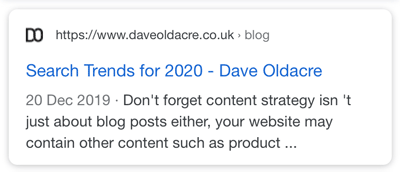Like any specialist skill, SEO has evolved over many years and can feel daunting to those new to it as a practitioner or business looking to use the channel to win business. Diving in feet first can feel like an adventure, however there are associated risks and getting something wrong can have significant consequences such as getting your website removed from the search results.
What if you're a small business, or in house marketeer with limited time and budgets to pay for an external agency? There are plenty of ways you can get started on your SEO journey without an immense technical know how and belwo are our 3 simple steps to help you begin to optimise your website to win more traffic from search results.
Before we start thought it's worth saying that there isn't a one trick pony, or a silver bullet when it comes to search engine success. You need time, effort and patience if you really want it to work hard for you.
Method 1: Page titles & descriptions
You not be aware of what a page title and description are. If you’re not, a page title is a little snippet of text you see in your browser tab on desktop or mobile (when you view all your open screens). It helps the user to recall what is in that open tab, it’s also the little snippet of text which is displayed for your website pages in search results.

The page description is often unseen by the user but again is used in search results with search engines using it to give more context to the results shown to the user.
Updating titles and descriptions is an easy win as they are accessible in your website content management system (CMS). It can be a small change which makes a big difference. A well writtten title and description can increase the chances of users clicking on your website over your competitors in search results and the more clicks your website gets, the more trusted it appears to search engine and so is shown more often.
But how do you write good titles and descriptions for your webpages? Here are some key things to consider:
- Titles
- Try to keep them under 65 characters
- Keep the title relevant to your page content
- Use a call to action to encourage the user to click
- Descriptions
- Length should be less than 140 characters
- Include 1 or 2 key messages
- Tell the user a bit more about the content of your page
Finally, make them unique to each page and don't forget to do your research either, have a look at what your competitors are doing!
Method 2: Review your content
Many websites have news and blog sections where businesses post new content about their business, what is often negleceted however is the review and updating of existing content in a website. This is an important sign of trust for search engines, showing that a website is maintained and up to date.
On top of this, updating the content on your website will ensure it remains relevant to the end user and relevant content will help build brand affinity, increasing the probablility of a user converting.
Method 3: Optimise your images
Slightly more complicated than the two above is image optimisation. Load time of your website is a key indicator for search engines and users, with many users expecting a website to load in less than 3 seconds and search engines aiming for sub 1 second. Image files can be a big contributor to increased load times, making them a key target for speed improvement.
Even if you’re not a photoshop pro, there are some easy steps you can take to optimise your existing images. Services such as such as our own website image and photo resizer which has been developed to allow you to make your existing images smaller without impacting on quality.
Results
If you do nothing else to your website this month, these SEO quick wins should help you get things moving in the right direction. They’re not going to be game changers for you but they are a good starting point and if you need help or support why not get in touch to see how we could help.





